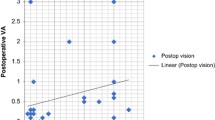Abstract
We evaluated the toxicity of perfluorooctylbromide in the primate eye as a short-term postoperative vitreous substitute. Four eyes of 4 African green monkeys underwent complete vitrectomy and vitreous replacement with 1.5–2.0 ml of PFOB. One additional animal received BSS as a control vitreous substitute in one eye. Animals were examined twice weekly for clarity and consistency of the vitreous replacement substance. Anterior segment and lenses remained clear in all eyes, although in the immediate postoperative period one eye became inflamed and had a culture-negative vitritis. The other eyes showed a minimal anticipated postoperative vitreous inflammation. Emulsification of the PFOB began within 3 days of injection and progressed up to 3 weeks, precluding fundus examination and fluorescein angiography after 2 weeks. Eyes were enucleated and light microscopy performed at 2 days, 10 days, 33 days, and 45 days. No toxic effects to the retinal cells were detectable by histological examination, but perivasculitis of retinal vessels was noted at 45 days. Indirect examination was normal up to 10 days; thereafter, the fundus view was obscured by the emulsified PFOB. Because of cellular migration into the vitreous cavity and retinal perivasculitis, observed histologically, PFOB seems most suitable for intraoperative rather than postoperative use.
Similar content being viewed by others
References
Bruneton JN, Falewée MN, François E, Cambon P, Philip C, Riess JG, Balu-Maestro C, Rozopoulos A. Liver, spleen and vessels: preliminary clinical results of CT with perfluorooctylbromide. Radiology 1989; 170: 179–83.
Chang S, Lincoff H, Zimmerman NJ, Fuchs W. Giant retinal tears: surgical techniques and results using perfluorocarbon liquids. Arch Ophthalmol 1989; 107: 761–6.
Chang S, Ozmert E, Zimmerman NJ. Intraoperative perfluorocarbon liquids in the management of proliferative vitreoretinopathy. Am J Ophthalmol 1988; 106: 668–74.
Chang S, Reppucci V, Zimmerman NJ, Heinemann MH, Coleman DJ. Perfluorocarbon liquids in the management of traumatic retinal detachments. Ophthalmology 1989; 96: 785–92.
Chang S, Zimmerman NJ, Iwamoto T, Ortiz R, Faris D. Experimental vitreous replacement with perfluorotributylamine. Am J Ophthalmol 1987; 103: 29–37.
Clark LC Jr, Gollan F. Survival of mammals breathing organic liquids equilibrated with oxygen at atmospheric pressure (letter). Science 1966; 152: 1755–6.
Flores-Aguilar M, Crapotta JA, Munguia D, Bergeron-Lynn G, Long D, Wiley CA, Freeman WR. Perfluorooctylbromide (PFOB) as a temporary vitreous substitute. Invest Ophthalmol Vis Sci 1991; 32 (suppl): 1225.
Haidt SJ, Clark LC, Ginsberg J. Liquid fluorocarbon replacement of the eye. Invest Ophthalmol Vis Sci 1982; 22 (suppl): 233.
Long DM, Long DC, Mattrey RF, Long RA, Burgan AR, Herrick WC, Shellhamer DF. An overview of perfluorooctylbromide — application as a synthetic oxygen carrier and imaging agent for X-ray, ultrasound, and nuclear magnetic resonance. Biomater Artif Cells Artif Organs 1988; 16 (1-3): 411–20.
Mattrey RF, Scheible FW, Gosink BB, Leopold GR, Long DM, Higgins CB. Perfluorooctylbromide: a liver/spleenspecific and tumor-imaging ultrasound contrast material. Radiology 1982; 145: 759–62.
Nabih M, Peyman G A, Clark LC Jr, Miceli MV, Abou-Steit M, Tawakol M, Liu KR. Experimental evaluation of perfluorophenanthrene as a high specific gravity vitreous substitute: A preliminary report. Ophthalmic Surg 1989; 20: 286–93.
Perk WW, Mattrey RF, Slutsky RA, Higgins CB. Perfluorooctylbromide: acute hemodynamic effects, in pigs, of intravenous administration compared with standard ionic contrast media. Invest Radiol 1984; 19: 129–32.
Peyman GA, Conway MD, Soike KF, Clark LC Jr: Longterm vitreous replacement in primates with intravitreal VitreonTMor VitreonTMplus silicone. Ophthalmic Surg 1991; 22: 657–64.
Zimmerman NJ, Faris D. The use of N-perfluorocarbon amines in complicated retinal detachments. Invest Ophthalmol Vis Sci 1984; 25 (Suppl): 258.
Author information
Authors and Affiliations
Additional information
Supported in part by U.S. Public Health Service grants EY07541 and EY02377 and NEI1F32EY06193-03 from the National Eye Institute, National Institutes of Health, Bethesda, MD, USA.
Rights and permissions
About this article
Cite this article
Conway, M.D., Peyman, G.A., Karaçorlu, M. et al. Perfluorooctylbromide (PFOB) as a vitreous substitute in non-human primates. Int Ophthalmol 17, 259–264 (1993). https://doi.org/10.1007/BF01007793
Received:
Issue Date:
DOI: https://doi.org/10.1007/BF01007793




